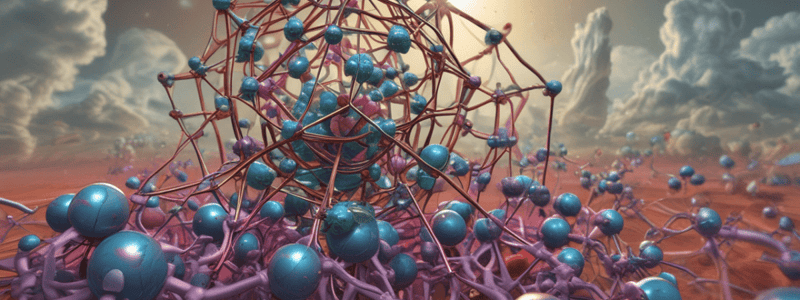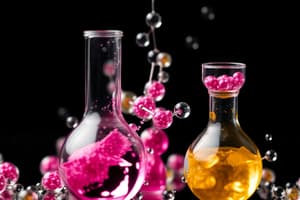Podcast
Questions and Answers
What is the older name for Chromium(II)?
What is the older name for Chromium(II)?
- Chromic
- Cuprous
- Ferric
- Chromous (correct)
What is the name of the Iron ion with a charge of 3+?
What is the name of the Iron ion with a charge of 3+?
- Ferric (correct)
- Iron(IV)
- Iron(II)
- Ferrous
What is the ion of Copper with a charge of 1+?
What is the ion of Copper with a charge of 1+?
- Cupric
- Cuprous
- Copper(I) (correct)
- Copper(II)
What is the older name for Mercury(I)?
What is the older name for Mercury(I)?
What is the ion of Tin with a charge of 2+?
What is the ion of Tin with a charge of 2+?
What is the older name for Lead(II)?
What is the older name for Lead(II)?
What is the ion of Cobalt with a charge of 3+?
What is the ion of Cobalt with a charge of 3+?
What is the ion of Chromium with a charge of 3+?
What is the ion of Chromium with a charge of 3+?
What is the ion of Iron with a charge of 2+?
What is the ion of Iron with a charge of 2+?
What is the older name for Copper(II)?
What is the older name for Copper(II)?
What is the meaning of the prefix 'tetra' in a chemical compound?
What is the meaning of the prefix 'tetra' in a chemical compound?
What is the name of the compound CuSO4 · 5H2O?
What is the name of the compound CuSO4 · 5H2O?
What is the molecular formula that corresponds to the empirical formula C2H5O?
What is the molecular formula that corresponds to the empirical formula C2H5O?
How many moles of oxygen are present in 35.51 g of oxygen?
How many moles of oxygen are present in 35.51 g of oxygen?
What is the process of determining the empirical formula of a compound?
What is the process of determining the empirical formula of a compound?
What is the first step in reducing the subscripts to whole numbers in the empirical formula?
What is the first step in reducing the subscripts to whole numbers in the empirical formula?
What does the suffix '-ous' indicate in the naming of ions?
What does the suffix '-ous' indicate in the naming of ions?
What is the name of the anion with the symbol F^-?
What is the name of the anion with the symbol F^-?
What is the name of the compound CaSO4 · ½H2O?
What is the name of the compound CaSO4 · ½H2O?
What is the symbol for the iodide ion?
What is the symbol for the iodide ion?
What is the name of the anion with the symbol O2^-?
What is the name of the anion with the symbol O2^-?
What does the prefix 'hemi' mean in the naming of hydrates?
What does the prefix 'hemi' mean in the naming of hydrates?
What is the name of the anion with the symbol S2^-?
What is the name of the anion with the symbol S2^-?
What is the name of the anion with the symbol N3^-?
What is the name of the anion with the symbol N3^-?
Flashcards are hidden until you start studying
Study Notes
Type II Cations
- Chromium forms two common cations: Cr²⁺ (chromous) and Cr³⁺ (chromic)
- Iron forms two common cations: Fe²⁺ (ferrous) and Fe³⁺ (ferric)
- Cobalt forms two common cations: Co²⁺ (cobaltous) and Co³⁺ (cobaltic)
- Copper forms two common cations: Cu⁺ (cuprous) and Cu²⁺ (cupric)
- Tin forms two common cations: Sn²⁺ (stannous) and Sn⁴⁺ (stannic)
- Mercury forms two common cations: Hg₂²⁺ (mercurous) and Hg²⁺ (mercuric)
- Lead forms two common cations: Pb²⁺ (plumbous) and Pb⁴⁺ (plumbic)
Common Monoatomic Anions
- Fluorine forms the anion F⁻ (fluoride)
- Chlorine forms the anion Cl⁻ (chloride)
- Bromine forms the anion Br⁻ (bromide)
- Iodine forms the anion I⁻ (iodide)
- Oxygen forms the anion O²⁻ (oxide)
- Sulfur forms the anion S²⁻ (sulfide)
- Nitrogen forms the anion N³⁻ (nitride)
- Phosphorus forms the anion P³⁻ (phosphide)
Hydrates
- Hemi- prefix indicates ½
- Mono- prefix indicates 1
- Di- prefix indicates 2
- Tri- prefix indicates 3
- Tetra- prefix indicates 4
- Penta- prefix indicates 5
- Hexa- prefix indicates 6
- Hepta- prefix indicates 7
- Octa- prefix indicates 8
Studying That Suits You
Use AI to generate personalized quizzes and flashcards to suit your learning preferences.




